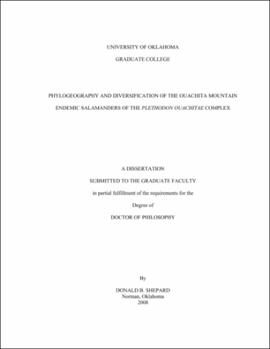| dc.description.abstract | Climatic changes associated with Pleistocene glacial cycles profoundly affected species distributions, patterns of inter-population gene flow, and demography. In species restricted to montane habitats, ranges may expand and contract along elevational gradients in response to environmental fluctuations resulting in alternating periods of connection and isolation. Periods of isolation may result in population divergence whereas periods of connectivity allow for dispersal and gene flow among mountains. The salamanders Plethodon ouachitae and Plethodon fourchensis are endemic to the Ouachita Mountains and are largely restricted to high-elevation, mesic forest. Because the ranges of these species span several mountains which are separated by more xeric, low-elevation valleys, the salamanders appear to be isolated on sky islands where gene flow among populations on different mountains may be restricted. I used DNA sequence data along with ecological niche modelling and coalescent simulations to test several hypotheses related to responses of montane species to Pleistocene glacial cycle-induced climatic shifts. Further, I analyzed morphological variation between species and among lineages within species to assess the extent of morphological divergence. My results revealed that P. ouachitae is composed of seven well-supported lineages structured across six major mountains whereas P. fourchensis is composed of four lineages structured across five montane isolates. Geographic breaks between lineages occurred in the vicinity of major valleys or high-elevation passes. Environmental conditions in intervening valleys were warmer and drier than conditions at locations where salamanders occurred, but ecological niche modelling predicted that suitable conditions were present between most mountains. Lineage diversification within each species occurred contemporaneously during the Middle Pleistocene, but diversification in P. ouachitae occurred in a stepping stone fashion compared to the fragmentation of a wide-ranging ancestor in P. fourchensis. Historical demographic analyses showed relatively stable population sizes over the last glacial cycle in P. ouachitae, but a gradual decrease in P. fourchensis. Both species, however, showed a slight to moderate amount of population growth in all lineages starting approximately 5 000-12 000 years ago, which coincides with the transition to the current interglacial period, the Holocene. Results from morphological analyses supported genetic evidence showing significant divergence between P. ouachitae and P. fourchensis, and among the different lineages within each species. My results not only demonstrate that climatic changes during the Pleistocene had profound effects on species restricted to montane habitats, but comparison of my results for P. fourchensis with its parapatric, sister taxon, P. ouachitae, emphasizes how responses can vary substantially even among closely related, similarly distributed taxa. The high level of diversity within P. ouachitae and P. fourchensis also has important implications for conservation because these endemic species have small ranges and lineages are usually restricted to single mountains. | |
